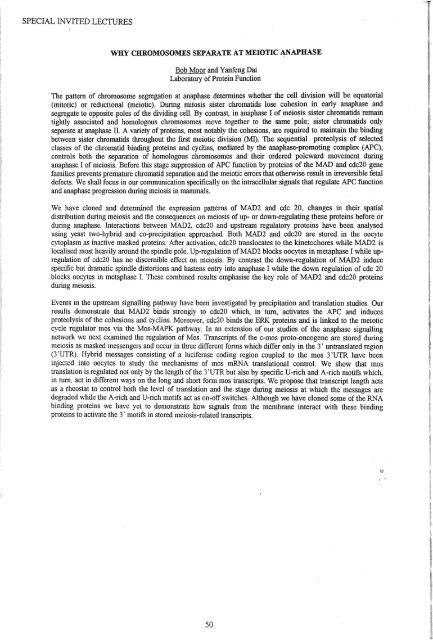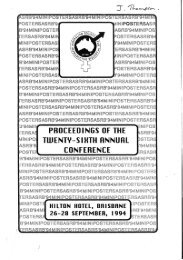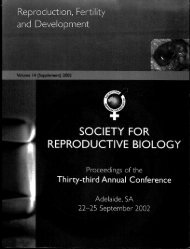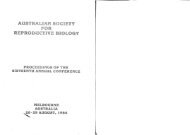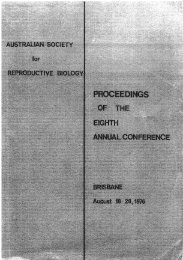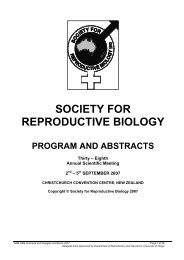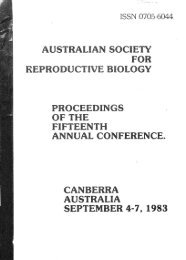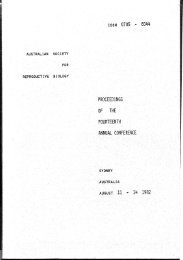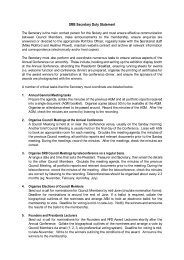ruoounu. nnSlunCIS&UINI-rOSIlnS - the Society for Reproductive ...
ruoounu. nnSlunCIS&UINI-rOSIlnS - the Society for Reproductive ...
ruoounu. nnSlunCIS&UINI-rOSIlnS - the Society for Reproductive ...
Create successful ePaper yourself
Turn your PDF publications into a flip-book with our unique Google optimized e-Paper software.
SPECIAL INVITED LECTURESMALE REPRODUCTIVE TRACT/SPERM FUNCTIONWHY CHROMOSOMES SEPARATE AT MEIOTIC ~APHASEBob Moor and Yanfeng DaiLaboratory ofProtein FunctionThe pattern of chromosome segregation at anaphase determines whe<strong>the</strong>r <strong>the</strong> cell division will be equatorial(mitotic) or reductional (meiotic). During mitosis sister chromatids lose cohesion in early anaphase andsegregate to opposite poles of<strong>the</strong> dividing cell. By contrast, in anaphase I of meiosis sister chromatids remaintightly associated and homologous chromosomes move toge<strong>the</strong>r to <strong>the</strong> same pole; sister chromatids onlyseparate at anaphase II. A variety of proteins, most notably <strong>the</strong> cohesions, are required to maintain <strong>the</strong> bindingbetween sister chromatids throughout <strong>the</strong> first meiotic division (MI). The sequential proteolysis of selectedclasses of <strong>the</strong> chromatid binding proteins and cyclins, mediated by <strong>the</strong> anaphase-promoting complex (APC),controls both <strong>the</strong> separation of homologous chromosomes and <strong>the</strong>ir ordered poleward movement duringanaphase I of meiosis. Be<strong>for</strong>e this stage suppression of APe function by proteins of <strong>the</strong> MAD and cdc20 genefamilies prevents premature chromatid separation and <strong>the</strong> meiotic errors that o<strong>the</strong>rwise result in irreversible fetaldefects. We shall focus in our communication specifically on <strong>the</strong> intracellular signals that regulate APC functionand anaphase progression during meiosis in mammals.We have cloned and determined <strong>the</strong> expression patterns of MAD2 and cdc 20, changes in <strong>the</strong>ir spatialdistribution during meiosis and <strong>the</strong> consequences on meiosis of up- or down-regulating <strong>the</strong>se proteins be<strong>for</strong>e orduring anaphase. Interactions between MAD2, cdc20 and upstream regulatory proteins have been analysedusing yeast two-hybrid and co-precipitation approached. Both MAD2 and cdc20 are stored in <strong>the</strong> oocytecytoplasm as inactive masked proteins. After activation, cdc20 translocates to <strong>the</strong> kinetochores while MAD2 islocalised most heavily around <strong>the</strong> spindle pole. Up-regulation ofMAD2 blocks oocytes in metaphase I while upregulationof cdc20 has no discernible effect on meiosis. By contrast <strong>the</strong> down-regulation of MAD2 inducespecific but dramatic spindle distortions and hastens entry into anaphase I while <strong>the</strong> down regulation of cdc 20blocks oocytes in metaphase I. These combined results emphasise <strong>the</strong> key role of MAD2 and cdc20 proteinsduring meiosis.Events in <strong>the</strong> upstream signalling pathway have been investigated by precipitation and translation studies. Ourresults demonstrate that MAD2 binds strongly to cdc20 which, in tum, activates <strong>the</strong> APe and inducesproteolysis of <strong>the</strong> cohesions and cyclins. Moreover, cdc20 binds <strong>the</strong> ERK proteins and is linked to <strong>the</strong> meioticcycle regulator mos via <strong>the</strong> Mos-MAPK pathway. In an extension of our studies of <strong>the</strong> anaphase signallingnetwork we next examined <strong>the</strong> regulation of Mos. Transcripts of <strong>the</strong> c-mos proto-oncogene are stored duringmeiosis as masked messengers and occur in three different <strong>for</strong>ms which differ only in <strong>the</strong> 3' untranslated region(3 'UTR). Hybrid messages consisting of a luciferase coding region coupled to <strong>the</strong> mos 3'UTR have beeninjected into oocytes to study tlle mechanisms of mos mRNA translational control. We show that mostranslation is regulated not only by <strong>the</strong> length of<strong>the</strong> 3'UTR but also by specific V-rich and A-rich motifs which.in tUlR act in different ways on tile long and short <strong>for</strong>m mos transcripts. We propose that transcript length actsas a rheostat to control both <strong>the</strong> level of translation and <strong>the</strong> stage during meiosis at which <strong>the</strong> messages aredegraded while <strong>the</strong> A-rich and V-rich motifs act as on-off switches. Although we have cloned some of <strong>the</strong> RNAbinding proteins we have yet to demonstrate how signals from <strong>the</strong> membrane interact with <strong>the</strong>se bindingproteins to activate <strong>the</strong> 3' motifs in stored meiosis-related transcripts.IMPACT OF EPIDIDYMAL MATURATION ON THE REDOX REGULATED PATHWAYSCONTROLLING SPERM CAPACITATIONBeverley Lewis and John Aitken* . .*School ofBiological and Chemical Sciences, University ofNewcastle and MRC <strong>Reproductive</strong> BIOlogyUnit, Edinburgh.IntroductionAs spermatozoa progress through <strong>the</strong> c.Pididymis<strong>the</strong>y acquire <strong>the</strong> competence to capaCItate. Thecellular mechanisms regulating this centralelement of <strong>the</strong> maturation process are notunderstood. .Tyrosine phosphorylation is widely regarded asone of <strong>the</strong> keystones of capacitation (1). Incapacitating spermatozoa, tyrosinephosphorylation is controll~d by a re~oxregulated cAMP mediated SIgnal transductioncascade that appears to be unique to this celltype (2-4). Since <strong>the</strong> function~l comp~t~nce ofthis unusual pathway dunng epIdIdymalmaturation has not been examined, an analysisofthis system was undertaken using <strong>the</strong> rat as ananimal model.MethodscAMP was monitored using <strong>the</strong> Biomol, <strong>for</strong>matA cyclic AMP enzyme immunoassay kit,acetylated version (Biomol" PA, ~SA).Tyrosine phosphorylation was detected WIth <strong>the</strong>PY20 monoclonal antibody (Affiniti, Exeter,UK) using conventional Western blot protoc~ls.Immunolocalization of <strong>the</strong> sites of tyrosmephosphorylation was achieved using an alkalinephosphatase labeled second antibody.ResultsThe induction of reactive oxygen speciesgeneration with NADPH resulted in an increasein intracellular cAMP in both caput and caudalspermatozoa, providing a phosphodiesteraseinhibitor was present in <strong>the</strong> <strong>for</strong>m ofpentoxifylline (Fig la). However only ir: maturecaudal epididymal spermatozoa did thIS redoxinduction of cAMP generation result in anincrease in tyrosine phosphorylation (Fig 1b).The functional development of this cAMPtyrosinephosphorylation path~ay d';1ringepididymal maturation was as.soc~ated WIth ashift in <strong>the</strong> cellular 10callzatlOn of <strong>the</strong>phosphorylation sites from <strong>the</strong> acrosome (Fig.1c) to <strong>the</strong> sperm tail (Fig. 1d)ConclusionsRedox regulation of cAMP generation is aconsistent feature of spenn biochemistrythroughout all stages of ~pididyrnalmaturation. However only In maturespennatozoa does cAMP induce <strong>the</strong>phosphorylation of a novel set of proteinsmany of which are located in <strong>the</strong> sJ?enn ~ail.In this location <strong>the</strong>se phosphoprotelns mIghtplay a key role in controlling <strong>the</strong> motilitychanges (hyperactivation) asssociated with <strong>the</strong>attainment ofa capacitated state.These results contribute to our understanding of<strong>the</strong> cellular mechanisms responsible <strong>for</strong>epididymal sperm maturation. Spe.cifically,<strong>the</strong>y focus attention on <strong>the</strong> mechamsms bywhich cAMP stimulates tyrosinephosphorylation, as <strong>the</strong> key event controlli~g <strong>the</strong>potential ofmaturing spermatozoa to capaCItate.WGo).,ac..2.0(00x 1.5li')E~ 1.0a.~


